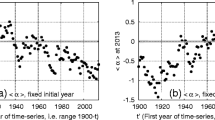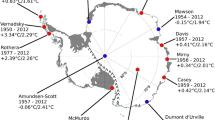Abstract
Studies on persistence are important for the clarification of statistical properties of the analyzed time series and for understanding the dynamics of the systems which create these series. In climatology, the analysis of the autocorrelation function has been the main tool to investigate the persistence of a time series. In this paper, we propose to use a more sophisticated econometric instrument. Using this tool, we obtain an estimate of the persistence in global land and ocean and hemispheric temperature time series.



Similar content being viewed by others
Notes
The authors are grateful to an anonymous referee for this comment.
References
Campbell JY, Mankiw NG (1987) Are output fluctuations persistent? Q J Econ 102(4):857–880
Cochrane JH (1988) How big is the random walk component in the GNP? J Polit Econ 96:893–920
Gay-Garcia C, Estrada F, Sánchez A (2009) Global and hemispheric temperatures revisited. Clim Chang 94:333–349
Kaufmann RK, Kauppi H, Stock JH (2006) The relationship between radiative forcing and temperature: what do statistical analyses of instrumental temperature record measure? Clim Chang 77:279–289
Liu H, Rodríguez G (2005) Human activities and global warming: a cointegration analysis. Environ Modell Softw 20:761–773
Mayadunne G, Evans M, Inder B (1995) An empirical investigation of shock persistence in economic time series. Econ Rec 71(213):145–156
Mills TC (2006) Modelling current trends in Northern Hemisphere temperatures. Int J Climatol 26(7):867–884
Mills TC (2013) Breaks and unit roots in global and hemispheric temperatures: an updated analysis. Clim Chang 118:745–755
Mosedale TJ, Stephenson DB, Collins M, Mills TC (2006) Granger causality of coupled climate processes: ocean feedback on the North Atlantic oscillation. J Clim 19:1182–1194
Pelletier JD, Turcotte DL (1997) Long-range persistence in climatological and hydrological time series: analysis, modeling and application to drought hazard assessment. J Hydrol 203:198–208
Stern DI, Kaufmann RK (1999) Econometric analysis of global climate change. Environ Modell Softw 14:597–605
Stern DI, Kaufmann RK (2000) Detecting a global warming signal in hemispheric series: a structural time series analysis. Clim Chang 47:411–438
Tol RS (1994) Greenhouse statistics-time series analysis: part II. Theor Appl Climatol 49:63–74
Wilks DS (2011) Statistical methods in the atmospheric sciences. Academic, New York
WMO (1966) Climatic change. WMO technical note 79. World Meteorological Organization, Geneva
Acknowledgments
The authors would like to thank an anonymous referee for the useful comments.
Author information
Authors and Affiliations
Corresponding author
Rights and permissions
About this article
Cite this article
Triacca, U., Pasini, A. & Attanasio, A. Measuring persistence in time series of temperature anomalies. Theor Appl Climatol 118, 491–495 (2014). https://doi.org/10.1007/s00704-013-1076-9
Received:
Accepted:
Published:
Issue Date:
DOI: https://doi.org/10.1007/s00704-013-1076-9




